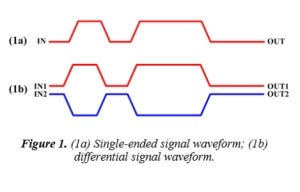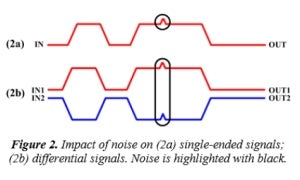
In previous installments of this series, we provided a general overview of the concept of impedance. In this installment, we shift gears to discuss differential signalling, the primary method that high-speed digital signals are transferred.
Differential signalling is a method of signal transfer that uses two signal paths. Whereas the alternative, single-ended signaling, transmits signals between one signal path and a reference ground path (Figure 1a), differential signaling transmits signals between two signal paths and a reference ground path (Figure 1b).
In differential signalling, two signals are transmitted with equal and opposite values, with the final result being the difference in voltage between the two signals. Differential signalling is the most common method for transmitting high-speed digital signals.
Differential signalling is used because it offers advantages over single-ended signalling. The main advantage is improved noise immunity, which minimises electromagnetic interference (EMI). To understand this, take a look at the signal waveforms in Figure 2.
The single-ended waveform is shown in Figure 2a; the differential waveform is shown in Figure 2b. The spike shown on the waveforms represents some external noise that is introduced into the system.
In the single-ended system, the noise will be detected at the output. However, as long as noise appears similarly on both differential lines (which it often does provided the lines are in close proximity), the output of a differential signal will be immune to external noise.

This is because the differential system output measures the difference between the two signals, cancelling out the noise at the output. Noise immunity is the biggest advantage that differential signals have over single-ended signals.
The other major benefit, particularly in cables and connectors, is that designing for a 100Ω differential impedance is easier than designing for 50Ω single-ended.
Since impedance is a function of geometry, this is simply a matter of physics. Standard non-impedance controlled designs have an impedance that is closer to 100Ω. Therefore, it typically requires less drastic design changes to match a system to 100Ω than it does to match to 50Ω.
The primary disadvantage to differential signalling is that it requires double the signal lines, adding space. This disadvantage, however, is often offset by the significant benefits that are inherent to differential signalling.
For most applications, the benefits of differential signalling outweigh the drawbacks. This is why we are increasingly seeing differential signalling applications, particularly when it comes to high-speed digital designs.

